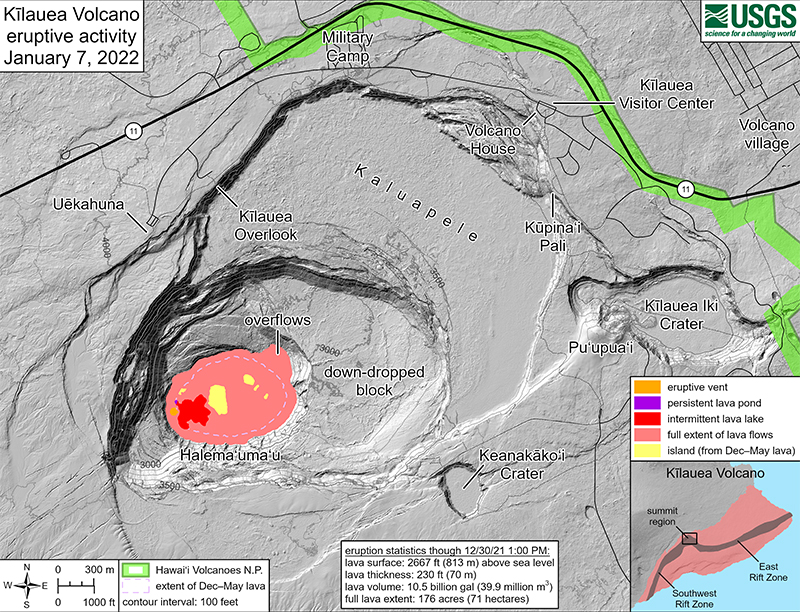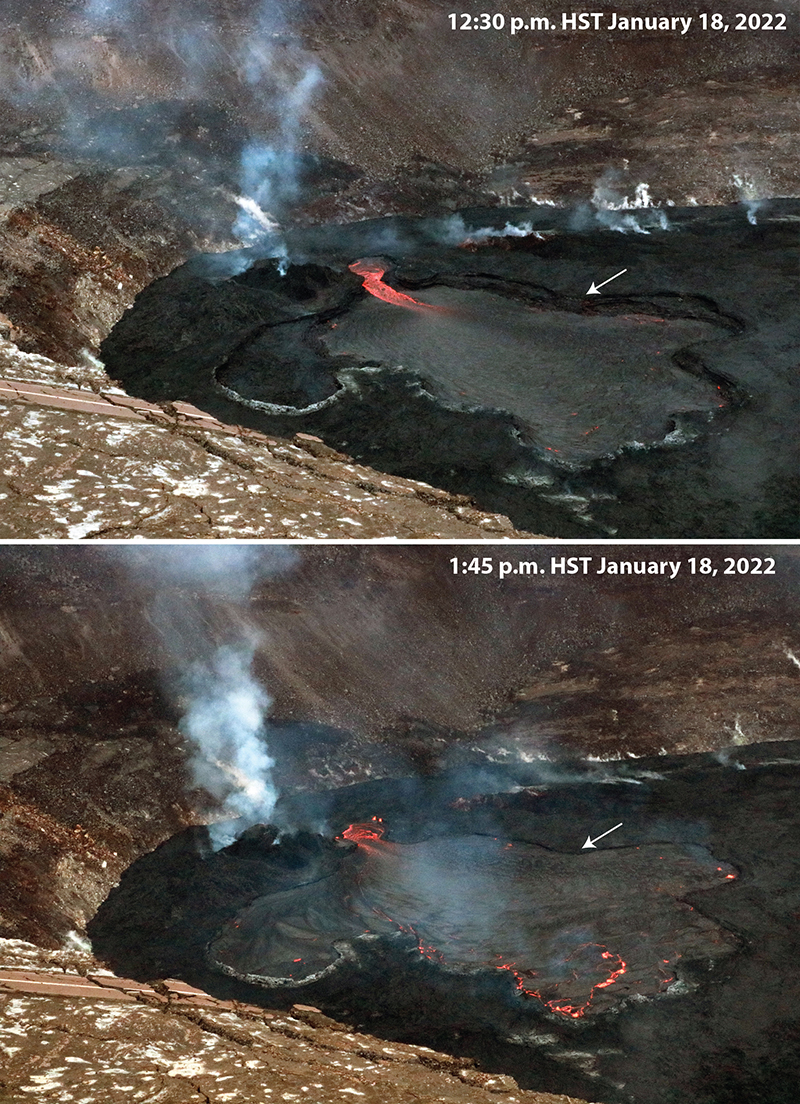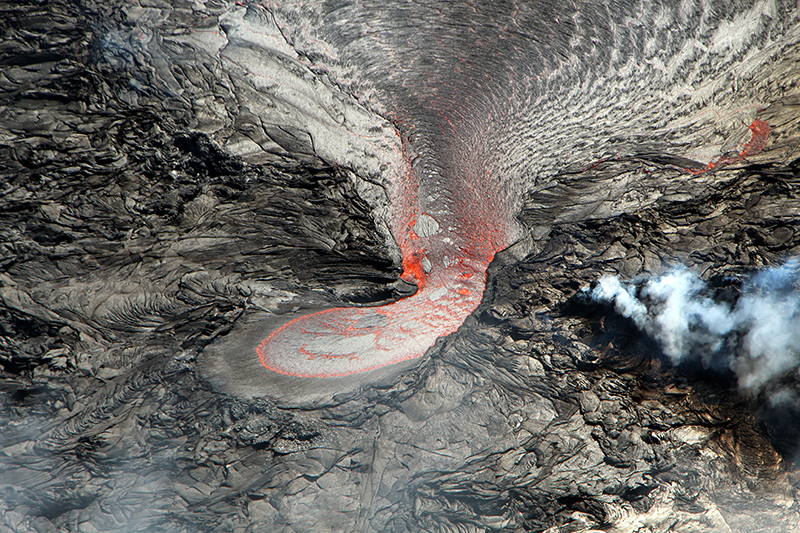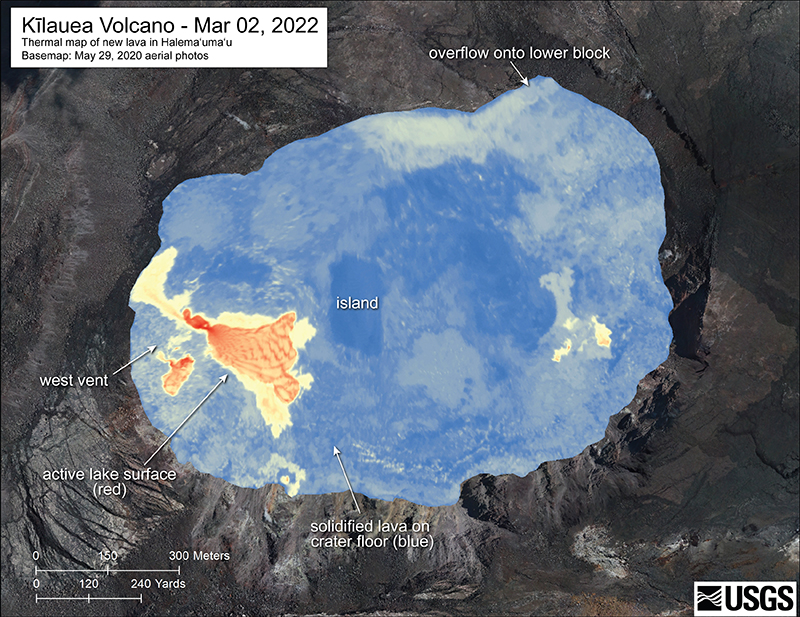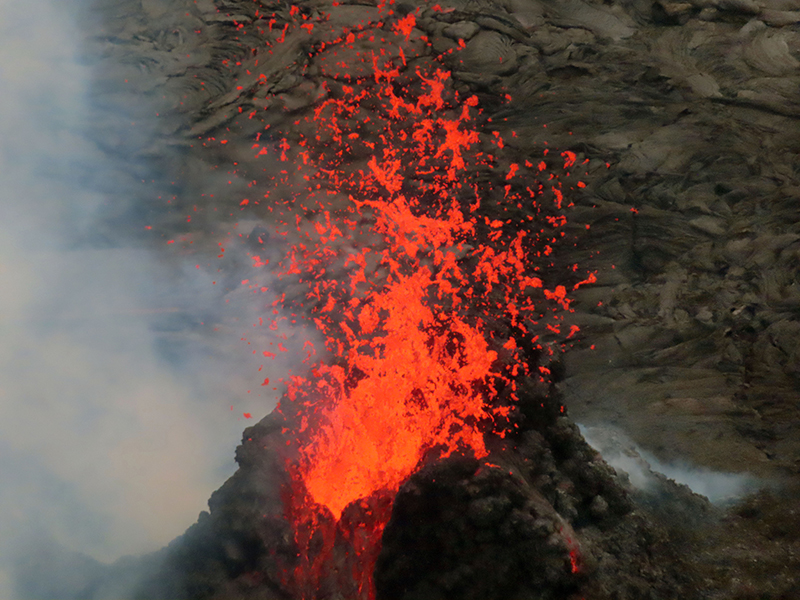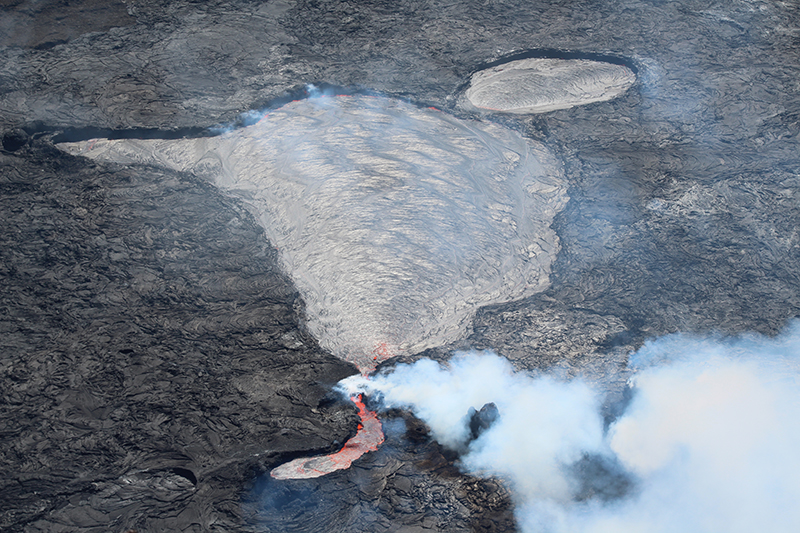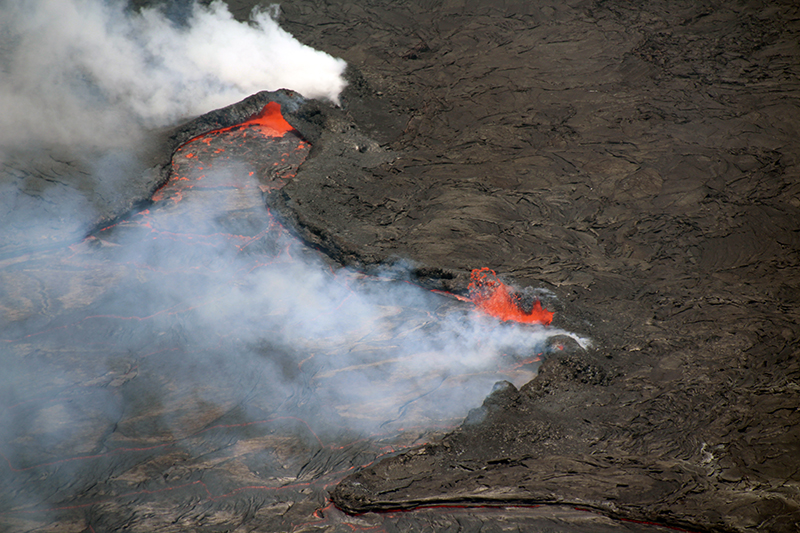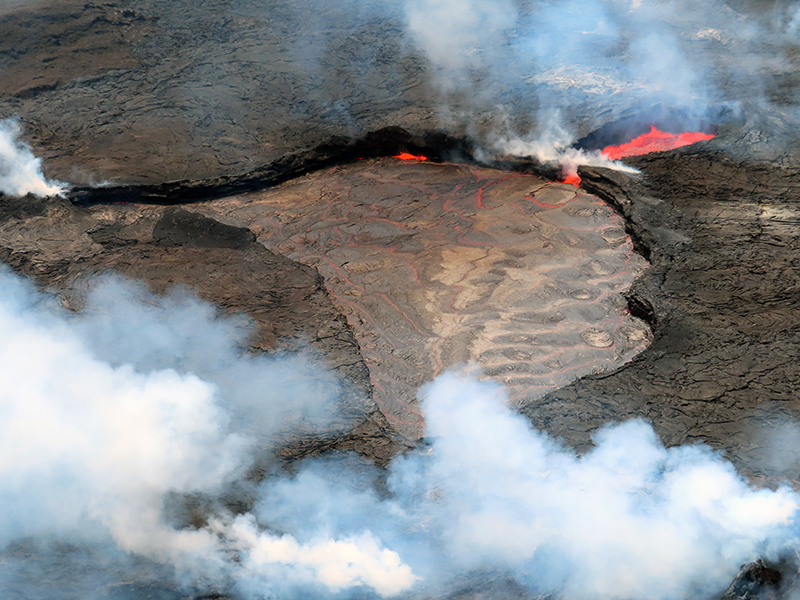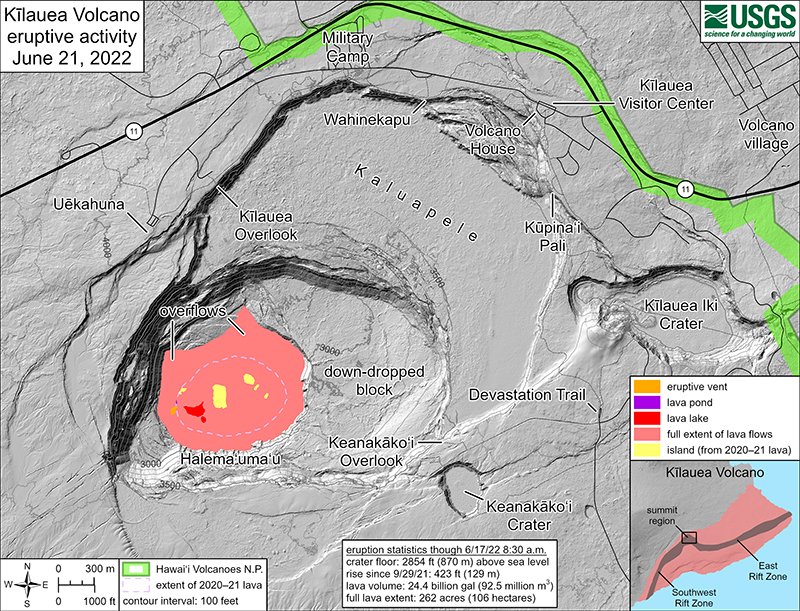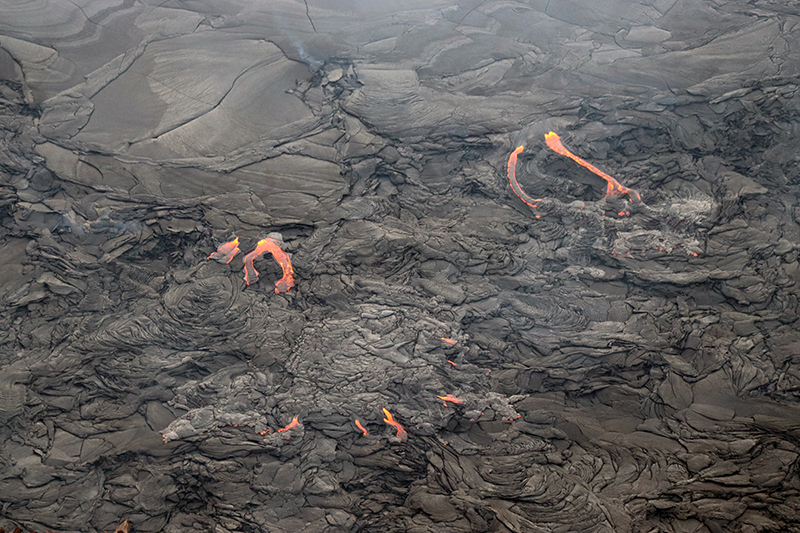Report on Kilauea (United States) — August 2022
Bulletin of the Global Volcanism Network, vol. 47, no. 8 (August 2022)
Managing Editor: Benjamin Andrews.
Edited by Kadie L. Bennis.
Kilauea (United States) Lava effusions persisted in the lava lake at Halema’uma’u during January-June 2022
Please cite this report as:
Global Volcanism Program, 2022. Report on Kilauea (United States) (Bennis, K.L., and Andrews, B., eds.). Bulletin of the Global Volcanism Network, 47:8. Smithsonian Institution.
Kilauea
United States
19.421°N, 155.287°W; summit elev. 1222 m
All times are local (unless otherwise noted)
Kīlauea is the southeastern-most volcano in Hawaii and overlaps the E flank of the Mauna Loa shield volcano. Its East Rift Zone (ERZ) has been intermittently active for at least 2,000 years. An extended eruption period began in January 1983 and was characterized by open lava lakes and lava flows from the summit caldera and the East Rift Zone. During May 2018 lava migrated into the Lower East Rift Zone (LERZ) and opened 24 fissures along a 6-km-long NE-trending fracture zone that produced lava flows traveling in multiple directions. Lava fountaining was reported in these fissures and the lava lake in Halema’uma’u crater drained (BGVN 43:10).
The current eruption period started during September 2021 and has included seismicity, new fissures on the Halema’uma’u crater that generated lava flows, lava fountaining, and an active lava lake (BGVN 47:01). Similar activity with intermittent pauses continued during this reporting period of January through June 2022 using daily reports, volcanic activity notices, and abundant photo, map, and video data from the US Geological Survey's (USGS) Hawaiian Volcano Observatory (HVO).
Summary of activity during January-June 2022. Activity at Kīlauea consisted of intermittent lava effusions from the western vent in the Halema’uma’u crater and ooze-outs along margins of the crusted over eastern side of the lake (figure 509). The lake had risen about 70 m since lava was first detected on 29 September 2021 and measurements from a helicopter overflight on 30 December 2021 indicated that the total erupted volume of lava since September was approximately 40 million cubic meters. Activity remained confined to the crater. Summit tiltmeters and nearby seismometers detected inflation and deflation events and volcanic tremors that rose and declined in frequency, reflective of pauses in the eruption. Sulfur dioxide emissions were frequently measured, reaching as much as 4,500 t/d on 1 February.
Activity during January 2022. The lava lake at the Halema’uma’u crater remained active during January, showing several large overflows onto older ones and strong crater incandescence. Lava was visible at the western vent of the crater at 1445 on 31 December and remained confined to the crater. Seismicity in the summit region remained below background levels, and the sulfur dioxide emission rate was approximately 5,000 tons/day (t/d), based on measurements from 28 December. Pause events occurred throughout much of the reporting period and were characterized by lower effusion rates, deflation events, and lower volcanic tremor events. HVO issued a notice on 2 January at 0914 stating that the eruption was entering a pause, meaning that lava effusions continued, but at a much lower rate. Summit tiltmeters tracked rapid deflation during the early morning of 2 January. In addition, volcanic tremor associated with the eruption and recorded by nearby seismometers, also rapidly decreased. The lava lake began to cool at the same time. A large breakout along the northern margin of the crusted-over lava lake was observed during the morning; no effusions were reported from the western vent.
At approximately 0400 on 5 January the summit eruption at Halema’uma’u crater resumed, beginning with volcanic tremors detected at 0340 and then lava erupting from the western vent. On 6 January the sulfur dioxide emission rate was 3,300 t/d. Following another short pause, lava effused from the western vent at 1840 on 11 January, and lava ooze-outs were observed along the margins of the crusted over eastern side of the lake. The lava lake rose approximately 13 m, which was then followed by decreases in the summit tilt, tremor, and lake level. The total volume of lava erupted measured on 14 January was 45 million cubic meters. On 16 January HVO reported that lava had stopped erupting from the western vent and the level of the lake surface had dropped about 10 m. Occasional minor activity was reported at the vent on the N side of the spatter cone, as well as small lava ooze-outs along the margins of the crusted over eastern side of the lake.
After another multi-day pause, lava returned to the western vent at 1045 on 18 January and by 1630 the lava lake level had increased by about 12 m (figure 510). There were also several ooze-outs along the SE and NW margins of the lake. The active lava lake was confined to a small pond north of the western vent overnight during 20 January. Just after 0400 on the morning of 21 January the rate of effusion had increased, and the lava lake remained confined to the western half of the crater. Two overflow events were reported during the night of 21 January, with lava flowing NW, SW, and SE out of the lava lake. In addition, several ooze-out events occurred along the NW, N, SE, and S margins of the lake. By this time, the lava lake level had increased about 83 m since the beginning of the eruption period in late September 2021. Again, activity was confined to a small pond N of the western vent and several long-lived ooze-outs occurred along the margins of the E and NW side of the crater. Lava effusions into the pond were intermittent, with several hours in between short-lived periods of lava input. On 19 January the rate of sulfur dioxide emissions was 2,100 t/d and another measurement taken on 24 January showed that the rate had decreased to 58 t/d.
During the morning of 25 January at 0552 a lava flow from the top of the western vent was observed that traveled W and N along the crater margin. The lava lake began to rise around 0630 and by 0820, it had risen 11 m. Overflows from the lava lake and the small pond N of the western vent, the largest of which were on the W and S margins, continued until the afternoon. A small lava flow was noted along the N margin of the larger inactive lava lake surface during the early morning of 27 January, and a small spatter zone that was active in the E section of the crater had produced a small and steep cone. Field crews working in the caldera on 27 January noted loud gas-jetting from the new cone that had developed earlier that morning. The sulfur dioxide emission rate was measured at 2,800 t/d on 25 January, during which time lava was being erupted from the western vent.
HVO reported that on at 0800 on 29 January there was no active lava visible in the Halema’uma’u crater, which indicated a pause in activity. The lava lake depth had very gradually decreased less than one meter. Some overturning during the afternoon was observed in the eastern part of the crater, which briefly exposed surficial lava, and circulating lava was occasionally visible in the small pond N of the western vent. Then, just before 2130 on 30 January, a lava overflow in the western vent occurred, moving NW. The small pond also began to quickly fill with lava, which flowed into the lava lake and occupied the W part of the crater by 2200. The lake began to rise and was overflowing by midnight. Lava flows travel to the S and then E along the margin of the crater. Lava also began to ooze out along the N margin of the larger inactive lava lake surface just after 0500 on 31 January.
Activity during February 2022. Lava continued to intermittently erupt from the western vent in the Halema’uma’u crater during February, with overflows feeding a lava flow to the SE along the S margin of the crater until 1100 on 31 January. Multiple ooze-outs occurred intermittently along the N, E, and S margins of the crater, some of which remained weakly active, with substantial portions of the inactive E lava lake being resurfaced by these flows. A small pond to the N of the western vent also fed the active part of the lava lake via a small lava flow (figure 511). The level of the lava lake continued to fluctuate, depending on the lava supply and summit inflation or deflation. The small spatter cone near the E end of the crater was less than 6 m tall and was erupting lava fountains up to approximately 10 m high for several hours during the night of 1 February and into early the next morning. These fountains fed a short lava flow that was contained near the E margin of the crater. The sulfur dioxide emission rate was approximately 4,500 t/d measured on 1 February and during an eruptive pause they were around 330 t/d on 8 February. A particularly vigorous ooze-out was observed at the far E side of the crater during 4-5 February. Heavy rain at the summit occurred between 1320 and 1800 on 13 February, which triggered spattering in the lava lake. As a result, there were brief decreases in the level of the lake during 1330 and 1557; the lake level returned to its pre-spatter measurement within an hour of each spattering episode. The sulfur dioxide emission rate was 2,800 t/d measured on 14 February.
Short-lived overflows of the active western lava lake to the W started around 1000 on 20 February, and were followed by lava flows coming from the western vent and flowing to the S and W an hour later, at 1100. Minor ooze-outs also continued intermittently along the crater floor margins. Lava continued to erupt from the western vent and move to the S, W, and into the western lava lake through the rest of the month. The sulfur dioxide emission rate was 2,500 t/d on 25 February. The Halema’uma’u crater floor had risen about 96 m since the eruption began in September 2021.
Activity during March 2022. Activity continued to fluctuate at the summit crater during March. Throughout February, the main western cone had broken down and by 4 March, lava effused from multiple vents, including the tallest cone (19 m high). The eruption was paused at 0130 on 1 March, meaning that the effusions from the western vent into the lava lake had diminished, though short-lived minor flows continued to be observed. These flows moved S, W, and into the western part of the lake, although they had stopped by the morning. Little to no ooze-outs along the crater margins were also reported. At 0100 on 2 March the eruption resumed, consisting of increased tremor that began 30 minutes earlier and continuous flows from the western vent moved to the S, W, and into the western lava lake (figure 512). During 4-5 March several ooze-outs were reported along the E and N margins of the crater floor. Spatter was also observed from the western vents on 4 March (figure 513). The total measured volume of the effusions since the start of the eruption was 53.6 million cubic meters on 4 March. During the early morning of 9 March, a small lava flow breakout began on the SE margin of the crater floor, but was already crusting over by 0900. The sulfur dioxide emission rate was approximately 2,200 t/d on 8 March and 1,900 t/d on 10 March. A sustained breakout from the NE edge of the crater began at around 1700 on 10 March and lasted until about 0630 the next day. On 11 March, HVO reported that lava was supplied from an embayment just N of the tallest cone in the western part of the crater, which had since grown to 27 m high (figure 514). Another small breakout occurred on the NW side of the crater floor from about 1700 on 12 March to 0500 the next day. Minor and slow crustal overturning occurred on the NW side of the crater floor during 13-14 March and began on the SE side of the crater floor edge, lasting for several hours.
At around 0700 on 16 March a lava flow that originated from the N part of the western vent area started to advance NW onto the crater floor and remained active for several hours into the early afternoon. At least one ooze-out occurred on the E crater floor. A lava flow advanced onto the NW crater floor from during noon to midnight on 18 March and 2100 to 0700 during 19-20 March. Measurements taken on 17 March showed that the total volume of lava erupted since the eruption began was 57.7 million cubic meters and the lava lake level had risen 89 m. HVO reported a notable ooze-out along the N margin of the crater floor at 0345 on 21 March and continued into the next day. Some ooze-outs were also observed along the N and S crater margins during 23-24 March. The sulfur dioxide emission rate measured on 23 March as approximately 1,400 t/d, which increased to 3,100 t/d on 29 March. Numerous and sustained ooze-outs along the margins of the crater floor continued but showed decreasing activity; by 29 March the volume of the lava effused measured 64 million cubic meters. During 30-31 March a hornito forming on the E side of the lake had a few periods of spattering throughout the day (figure 515).
Activity during April 2022. Intermittent activity continued during April with numerous and sustained ooze-outs along the NW, NE, and E half of the crater floor, occasional crustal overturning on the NW margin, and lava effusions from the western vent into the lava lake. On 6 April ooze-outs were observed along the NW margin of the crater floor, as well as the E half. The active part of the lava lake showed continuous surface activity and had risen about 1 m. The sulfur dioxide emission rate was 3,400 t/d on 5 April and 3,200 t/d on 6 April. The crater floor had risen about 99 m since the beginning of the eruption, and approximately 66 million cubic meters of lava had been erupted. Overnight on 8 April a small breakout from the active western part of the lava lake was observed, in addition to a small ooze-out along the E lake margin. Small ooze-outs were also detected during 9-10 April along the NW, E, and SE lake margins. Shortly after 2315 on 10 April a surface flow emerged from the S side of the western vent. The flow traveled S on the crater floor and covered the SW and W lake margin and remained active through 14 April. The sulfur dioxide emission rate measured 1,300 t/d on 8 April. Sporadic lava breakouts also occurred along the E, NE, S, and N lake margins. By 17 April lava flowed from the breakouts along the margins of the crater: N to the NE, and a smaller one to the S. During the morning of 27 April and into the next day, HVO reported increased roiling and spattering in the SE portion of the lake, particularly to the E. Sporadic breakouts also continued along the crater margins, particularly to the E. On 27 April the sulfur dioxide emission rate increased to 4,300 t/d, but dropped to 1,800 t/d by the next day.
Activity during May 2022. Lava continued to effuse into the lava lake and onto the crater floor during May; the active part of the lake showed continuous surface activity. The level of the lake fluctuated as a result of inflation, sporadic to continuous breakouts along the margins of the crater, and lava effusions. A particularly vigorous and expansive ooze-out began along the NW margin after 0200 on 5 May, accompanying relatively sluggish lava ooze-outs along the NE and S margins of the crater floor. Around 0700 on 7 May a new lava flow effused from the western vent onto the crater floor, but had stalled an hour later. The sulfur dioxide emission rate was 2,600 t/d on 4 May and 2,800 t/d on 12 May. Overflight measurements taken on 10 May indicated that the crater floor had risen about 106 m and 77 million cubic meters of lava had been effused since the September 2021. On 18 May HVO reported that the lake was draining into a small pond while spatter occurred along the margins of the crater (figure 516). This activity was also accompanied by loud whooshing and roiling noises, sometimes audible from the Keanakako‘i public overlook. On 31 May the sulfur dioxide emissions rate was 3,900 t/d.
Activity during June 2022. During June, lava effusions persisted from the Halema’uma’u western vent into the active lava lake, in addition to frequent ooze-outs along the E, NE, NW, W, S, and N crater floor margins and some spattering activity at the margins. Minor fluctuations in the lava lake level were also recorded throughout the month due to consistent surface activity. The sulfur dioxide emission rate was approximately 2,500 t/d on 2 June and 1,350 t/d on 10 June. On 10 June an overflow from the western vent produced a lava flow that moved onto the W side of the crater floor. Overflight measurements made on 17 June indicated that the crater floor had risen about 120 m and that 93 million cubic meters of lava had been effused since the start of the eruption (figure 517). On 24 June there was a small zone of weak ooze-outs effusing from the crater floor (figure 518). The sulfur dioxide emission rates were measured again on 23 and 29 June that were 3,000 t/d and 1,200 t/d, respectively.
Geological Summary. Kilauea overlaps the E flank of the massive Mauna Loa shield volcano in the island of Hawaii. Eruptions are prominent in Polynesian legends; written documentation since 1820 records frequent summit and flank lava flow eruptions interspersed with periods of long-term lava lake activity at Halemaumau crater in the summit caldera until 1924. The 3 x 5 km caldera was formed in several stages about 1,500 years ago and during the 18th century; eruptions have also originated from the lengthy East and Southwest rift zones, which extend to the ocean in both directions. About 90% of the surface of the basaltic shield volcano is formed of lava flows less than about 1,100 years old; 70% of the surface is younger than 600 years. The long-term eruption from the East rift zone between 1983 and 2018 produced lava flows covering more than 100 km2, destroyed hundreds of houses, and added new coastline.
Information Contacts: Hawaiian Volcano Observatory (HVO), U.S. Geological Survey, PO Box 51, Hawai'i National Park, HI 96718, USA (URL: http://hvo.wr.usgs.gov/).


